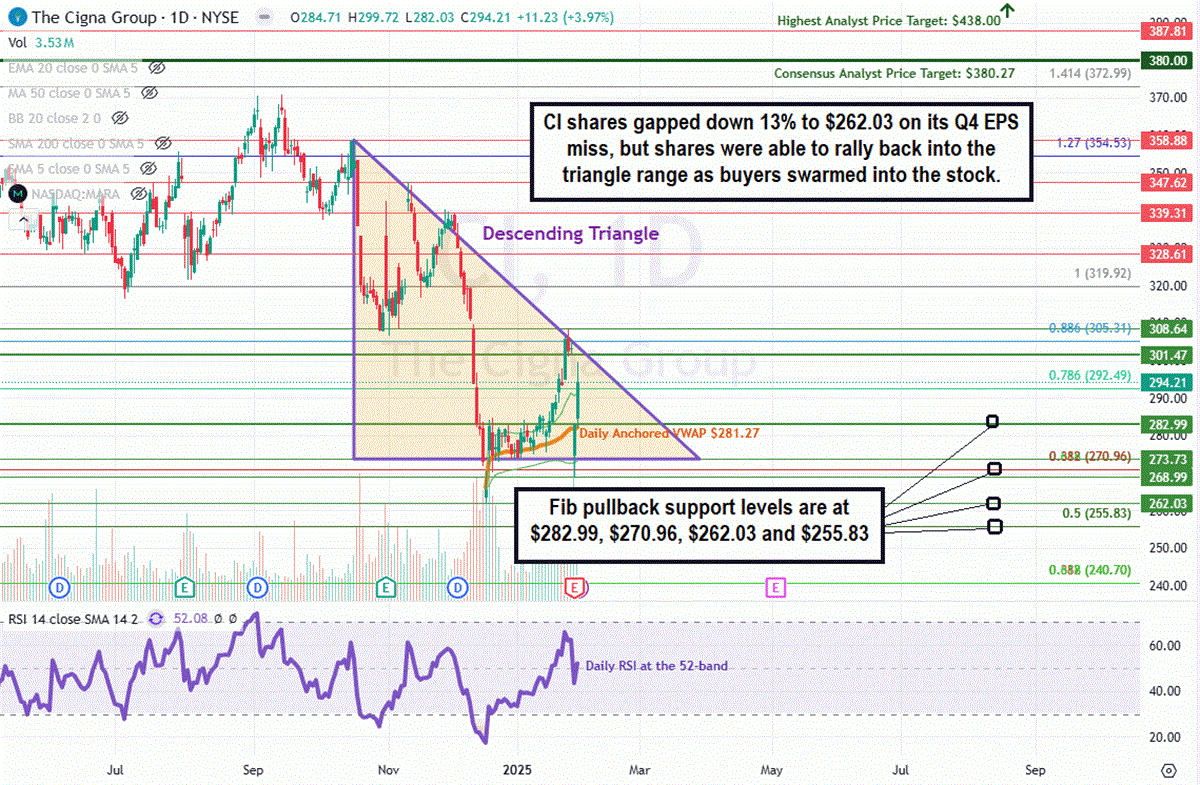The Cigna Group Today
CI
The Cigna Group
$335.60 -0.10 (-0.03%) As of 04/25/2025 03:59 PM Eastern
- 52-Week Range
- $262.03
▼
$370.83 - Dividend Yield
- 1.80%
- P/E Ratio
- 27.42
- Price Target
- $373.56
Leading health insurer Cigna Group Inc. NYSE: CI was praised for having the foresight to divest its Medicare Advantage (MA) business before rising acute care utilization rates would impact its medical care ratio (MCR) or medical benefits ratio (MBR), which the percentage of medical premiums paid out for medical reimbursement claims.
MCR levels have surged for other MA plan providers like CVS Health Co. NYSE: CVS and Humana Inc. NYSE: HUM. The medical sector leader posted its fourth quarter of 2024 earnings results, which triggered a 13% sell-off the following morning as its MCR surged to 87.9%, up from 82.2% last year. If one of the most efficient health insurers can’t keep a lid on its MCR, what does it mean for the rest of the health insurance industry?
While Q4 EPS Was Missed, Revenue Growth Was Impressive
The Cigna Group Stock Forecast Today
12-Month Stock Price Forecast:$373.5611.31% UpsideBuyBased on 19 Analyst Ratings | Current Price | $335.60 |
|---|
| High Forecast | $438.00 |
|---|
| Average Forecast | $373.56 |
|---|
| Low Forecast | $323.00 |
|---|
The Cigna Group Stock Forecast DetailsFor its fourth quarter of 2024, Cigna posted an EPS of $6.64, which missed consensus analyst estimates by $1.18. Revenues surged 28.4% YoY to $65.68 billion, crushing the $63.44 billion consensus estimates by $2.24 billion. Evernorth Health Services is its integrated health and pharmacy benefits manager (PBM) services segment, which generates 60% of earnings.
Cigna Healthcare is the insurance segment, generating 40% of earnings. Evernorth experienced 14% YoY earnings growth in Q4 to $2.15 billion, while Cigna Healthcare EPS fell 47% to $511 million. Overall EPS fell 2% YoY to $6.64 per share.
For the full year 2024, Cigna revenues grew 27% YoY to $247 billion. Full-year adjusted EPS rose 9% to $27.33 per share. The company raised its dividend to $1.51 per share and increased its stock buyback program by an extra $6 billion, bringing the total authorization to $10.3 billion.
Cigna guided 2025 in line with EPS of at least $29.50 versus $31.48 consensus estimates. Revenues are expected to be at least $252 billion versus $252.31 billion consensus analyst estimates.
Medical Care Ratio Reflects Rising Healthcare Costs
The main culprit behind the earnings miss was its Stop Loss insurance (SLI) product, which is directly tied to healthcare costs. The higher medical costs in its SLI directly impacted earnings. Its MCR rise to 87.9% underscored rising healthcare costs. With SLI, the fourth quarter is when more client settlements occur, and the trend has been climbing for higher-dollar claims. Cigna had begun pricing its SLI for this trend but didn’t capture the full extent of the acceleration as it materialized in Q4.
CEO David Cordani commented, “First, our fourth quarter results were below expectations due to higher-than-expected medical costs in our stop-loss product within Cigna Healthcare. We are taking corrective actions on this near-term pressure and expect to recapture the margin over the next two years. This is a specific issue we identified and are mitigating. I'll reinforce that we believe our U.S. employer and Cigna Healthcare businesses are strong and remain well positioned, and we're confident in our long-term growth strategy.” Cordani hopes to recapture 100 bps of margin in the Cigna Healthcare segment over the following two years.
CI Stock Is Contained Within a Descending Triangle Pattern
A descending triangle is normally a bearish chart pattern. It is comprised of descending (falling) upper trendline resistance capping bounces converging with a flat-bottom lower trendline that provides a floor on pullbacks. A breakdown triggers if the stock falls below the lower trendline support. However, a breakout can trigger if the stock surges up through the upper trendline resistance.

CI formed a descending triangle with the descending upper trendline resistance commencing at $358.88, converging with the flat-bottom lower trendline support at $273.73. The upper trendline resistance indicates lower highs on the bounce, and the lower trendline support indicates a floor on sell-offs. This was tested on its 13% earnings gap down to the $262.03 low on the release, but buyers held the flat bottom and coiled CI shares back into the triangle range, bouncing almost back to the $301.47 gap fill. The daily anchored VWAP is at $281.27, and the daily RSI is coiling back up at the 52-band. Fibonacci (Fib) pullback support levels are $282.99, $270.96, $262.03, and $255.83.
CI stock’s average consensus price target is 29.35% higher at $380.27, and its highest analyst price target sits at $438.00. It has 15 analysts' Buy ratings and one Hold rating. The stock has a 1.52% short interest.
Bullish investors can consider using cash-secured puts at the Fib pullback support levels to buy the dip. If assigned the shares, then writing covered calls at upside Fib levels executes a wheel strategy for income.
Before you consider The Cigna Group, you'll want to hear this.
MarketBeat keeps track of Wall Street's top-rated and best performing research analysts and the stocks they recommend to their clients on a daily basis. MarketBeat has identified the five stocks that top analysts are quietly whispering to their clients to buy now before the broader market catches on... and The Cigna Group wasn't on the list.
While The Cigna Group currently has a Buy rating among analysts, top-rated analysts believe these five stocks are better buys.
View The Five Stocks Here
MarketBeat just released its list of 10 cheap stocks that have been overlooked by the market and may be seriously undervalued. Enter your email address and below to see which companies made the list.
Get This Free Report
Like this article? Share it with a colleague.
Link copied to clipboard.